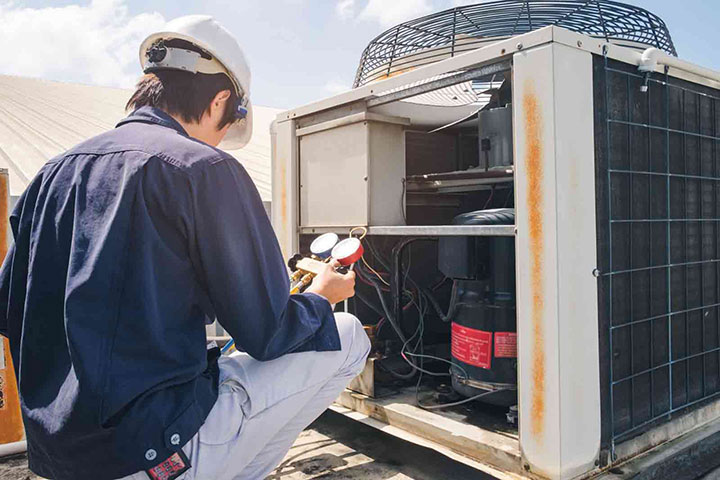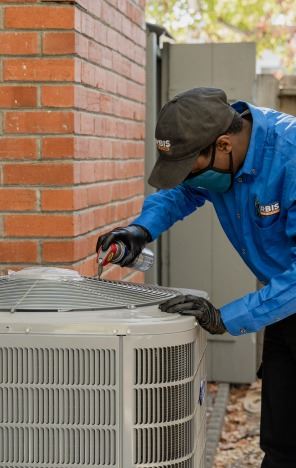When and Why to Schedule heat pump replacement ooltewah tn
When and Why to Schedule heat pump replacement ooltewah tn
Blog Article
Just How a Heatpump and Furnace Interact to Optimize Your Home's Home heating Performance
Understanding how a warmth pump and heater interact is important for home owners seeking effective heating solutions. Each system has its strengths, giving a balanced method to home convenience. The warm pump succeeds in modest temperature levels, while the heating system supplies fast heat throughout extreme cold. This harmony not only reduces power costs however likewise improves the life expectancy of both devices. What factors affect this partnership, and just how can homeowners maximize their advantages?
Understanding Warm Pumps: How They Work
Several people may be unfamiliar with their inner operations, warm pumps play a necessary duty in modern-day home heating systems. These tools operate by moving warm from one location to another, using the principles of thermodynamics. In chillier months, a warmth pump extracts warmth from the outdoors air, ground, or water, and transfers it inside to warm the space. On the other hand, during warmer months, it can turn around the process, functioning as an a/c by eliminating warmth from inside to the outside.Heat pumps consist of an evaporator, condenser, expansion, and compressor valve. The cooling agent within the system takes in warm as it vaporizes at reduced temperature levels and pressures. The compressor then enhances the stress and temperature level of the refrigerant, enabling it to release warmth as it condenses. This efficient process can significantly lower energy usage contrasted to standard heating approaches, making warmth pumps a lasting selection for environment control in homes.
The Duty of Furnaces in Home Heating
Heating systems play an important function in home heating by giving a reliable resource of heat throughout the chillier months. They operate by generating heat via combustion or electric resistance, dispersing it throughout the home using air ducts or radiant systems. The effectiveness of a heating system is typically measured by its Yearly Gas Usage Efficiency (AFUE) ranking, which shows just how properly the device converts gas into heat.Furnaces can make use of different energy sources, including gas, electricity, oil, or propane, enabling homeowners to pick the most suitable choice for their requirements. Unlike heatpump, which might struggle in severe cold, furnaces keep consistent efficiency, guaranteeing that interior temperature levels remain comfortable despite outdoor problems. In addition, modern furnaces often come outfitted with sophisticated innovation, such as variable-speed blowers and wise thermostats, boosting their effectiveness and responsiveness. This versatility makes furnaces a critical component in all-inclusive home heating techniques.

Advantages of Utilizing Both Solutions Together
Incorporating the toughness of both heaters and heatpump can result in a more reliable and effective home heating solution. Utilizing both systems permits house owners to make use of the heatpump's power effectiveness during milder temperature levels while depending on the furnace for even more severe cold conditions. This double method can significantly decrease power expenses, as heatpump eat less electricity than conventional home heating techniques when temperatures are moderate.Additionally, utilizing both systems together can boost comfort levels in the home. Warmth pumps can give regular, even home heating, while furnaces can quickly elevate ambient temperatures when needed. Moreover, the integration of both systems can expand the lifespan of equipment by reducing deterioration on each unit, as they share the workload. Ultimately, property owners can enjoy a balanced, cost-efficient heating option that readjusts perfectly to differing weather conditions, guaranteeing a warm and welcoming home throughout the cold weather.
How Warm Pumps and Furnaces Enhance Each Other
When homeowners incorporate heatpump and heating systems, they produce a complementary furnace that takes full advantage of performance and comfort. Heatpump run by moving heat from the outside air or ground, making them extremely effective in moderate climates. They stand out throughout milder temperature levels, offering affordable heating. Conversely, heaters produce warmth through combustion or electric resistance, providing solid, immediate heat during severe cold conditions.The mix of these 2 systems enables dynamic changes based upon temperature level variations. Throughout warmer months or milder winter days, the warmth pump can take the lead, preserving energy and lowering costs. As temperature levels decrease, the furnace can flawlessly involve, ensuring constant heat throughout the home. This harmony not just enhances power usage but additionally enhances the life expectancy of both systems, as each system operates within its perfect efficiency array. With each other, they develop a balanced setting that adapts to varying climate needs.
Enhancing Efficiency: Tips for Homeowners
Home owners can improve their home heating performance through numerous sensible strategies. Developing a normal maintenance schedule, incorporating smart thermostat modern technology, and implementing efficient insulation and securing services are vital actions. These procedures not just boost convenience yet likewise minimize power expenses.
Regular Upkeep Schedule
To assure optimal heating effectiveness, establishing a routine maintenance routine is necessary for any home. House owners must prioritize regular assessments of both warmth pumps and heaters to ascertain peak efficiency. This includes transforming air filters every one to 3 months, as blocked filters can significantly minimize effectiveness. In addition, scheduling specialist upkeep at least once a year permits specialists to recognize and deal with possible problems prior to they escalate. House owners should also cleanse the warm pump's exterior system to stop particles accumulation that can prevent airflow. By sticking to a regular maintenance timetable, homeowners not only improve their heating unit' effectiveness but likewise expand their life-span, leading to higher convenience and reduced energy costs throughout the cooler months.
Smart Thermostat Assimilation
Incorporating a clever thermostat into a home heating system can significantly enhance energy effectiveness, especially as it enables accurate control over temperature settings. These tools can discover the property owner's schedule and preferences, automatically readjusting the temperature to optimize convenience while lessening energy usage. For circumstances, they can reduce heating throughout times when the home is unoccupied, lowering unneeded usage. Many wise thermostats likewise provide real-time power usage information, allowing house owners to make educated choices concerning their heating behaviors. Furthermore, remote accessibility using smart device apps enables customers to adjust setups from anywhere, making sure the home is warm look these up upon return. Generally, clever thermostat combination not only enhances convenience yet significantly contributes to energy financial savings and efficiency.
Insulation and Sealing Solutions
Smart thermostats play an essential duty in energy effectiveness, yet their effectiveness can be substantially enhanced by appropriate insulation and securing options. Property owners need to prioritize insulating floorings, attic rooms, and wall surfaces to lessen warmth loss. Top notch insulation materials, such as spray foam or fiberglass, can considerably boost thermal resistance. In addition, securing gaps around doors, air ducts, and home windows prevents cool air infiltration and warmth retreat. Weatherstripping and caulking work approaches for addressing these leaks - heat pump replacement ooltewah tn. Normal examinations for air leakages, together with using blower door examinations, can assist identify trouble locations. By buying insulation and securing, homeowners can enhance the performance of their heating unit, inevitably leading to decreased energy consumption and reduced energy expenses
Typical Myths About Warmth Pumps and Furnaces
What false impressions surround heatpump and heating systems? Numerous individuals wrongly think that heatpump are inefficient in colder climates. In truth, contemporary heatpump are made to run successfully also in low temperature levels, offering trusted home heating throughout wintertime. Another usual myth is that heating systems are constantly a lot more efficient than warmth pumps. This depends on the specific power sources and performance rankings of the systems in inquiry. Some may also assume that using both systems all at once is unnecessary, yet as a matter of fact, this mix can optimize home heating effectiveness, specifically during extreme climate conditions. Additionally, people usually presume that heatpump need constant maintenance, when truthfully, they have similar maintenance needs to typical furnace. By debunking these misconceptions, house owners can make even more informed choices concerning their home heating options, eventually bring about improved comfort and power performance in their homes.
Maintenance Considerations for Combined Solutions

Frequently Asked Inquiries
Can Warm Pumps Job Effectively in Very Cold Climates?
Heatpump can battle in incredibly chilly environments as a result of reduced performance and heat extraction restrictions. Developments in innovation have led to designs created for far better efficiency in such problems, enhancing their practicality in extreme settings.
Just How Long Do Warmth Pumps and Furnaces Typically Last?
Heat pumps typically last 15 to 20 years, while heating systems have a life-span of 15 to 30 years. Normal upkeep can expand their durability, making certain reliable procedure and minimizing the requirement for premature replacements.

What Is the Typical Price of Setting Up Both Systems?
The average price of installing both a heat pump and a heating system usually ranges between $5,000 to $10,000 - heat pump service. Variables influencing this expense include system size, installment complexity, and regional labor rates
Are There Tax Obligation Motivations for Utilizing Energy-Efficient Heating Equipments?
Lots of house owners inquire about tax motivations for energy-efficient home heating systems. Numerous federal and state programs frequently provide credit reports or discounts, urging the adoption of sustainable modern technologies to decrease energy intake and promote environmental obligation.
Exactly how Do I Pick the Right Size Heatpump and Heater?
Picking the appropriate size heatpump and heater involves calculating the home's square video, thinking about insulation high quality, and evaluating local climate. Consulting a professional can assure ideal system efficiency and energy efficiency based upon details demands. furnace replacement. Comprehending just how a heat pump and heater work together is vital for home owners looking for reliable home heating remedies. In chillier months, a heat pump removes navigate to these guys warmth from the outdoors air, ground, or water, and transfers it inside your home to warm up the living space. When homeowners incorporate warm pumps and furnaces, they produce a complementary home heating system that maximizes effectiveness and comfort. Warm pumps run by moving warm from the outdoors air or ground, making them click very reliable in moderate environments. Heat pumps can battle in exceptionally cold climates due to decreased efficiency and heat extraction constraints
Report this page